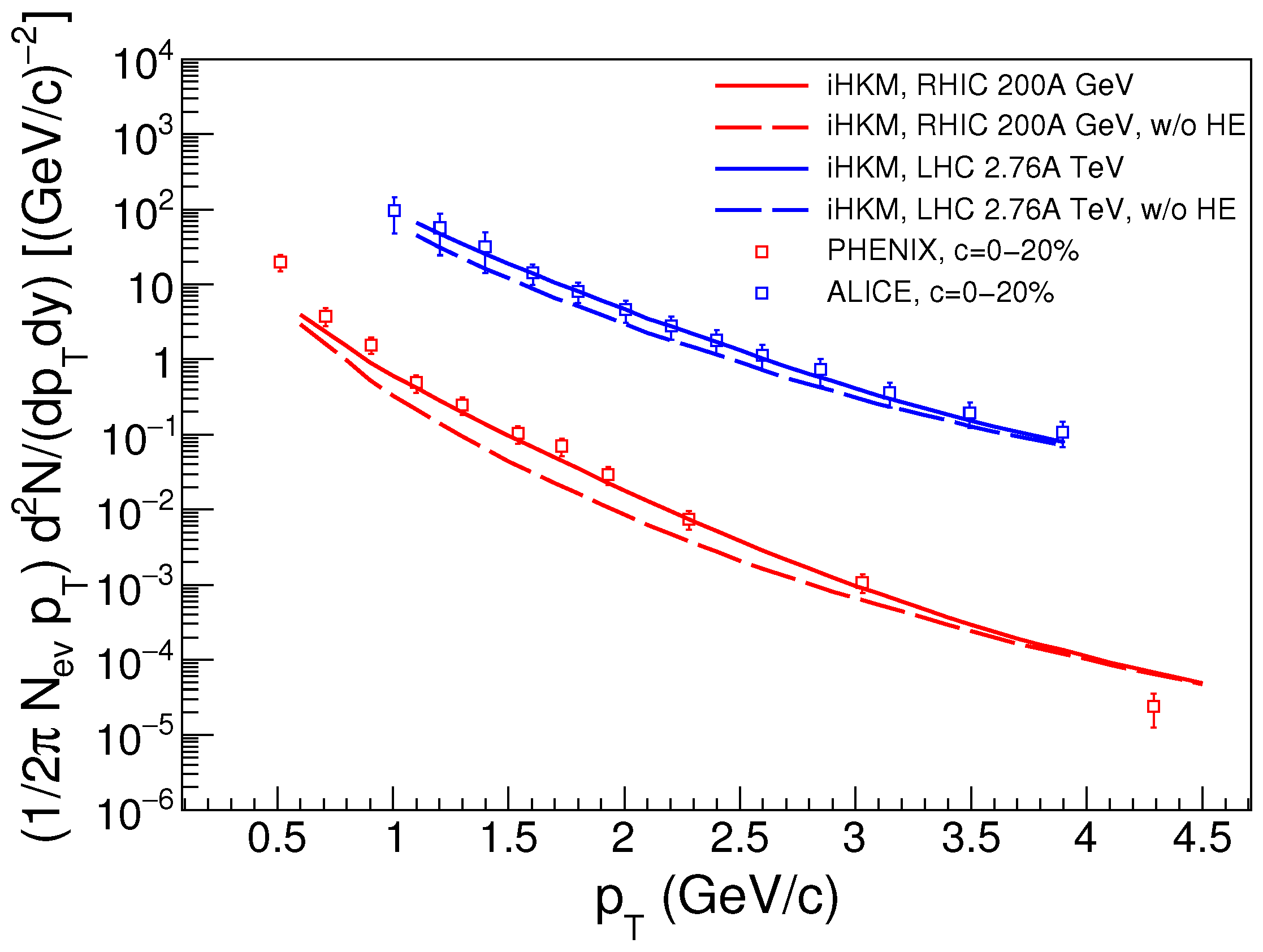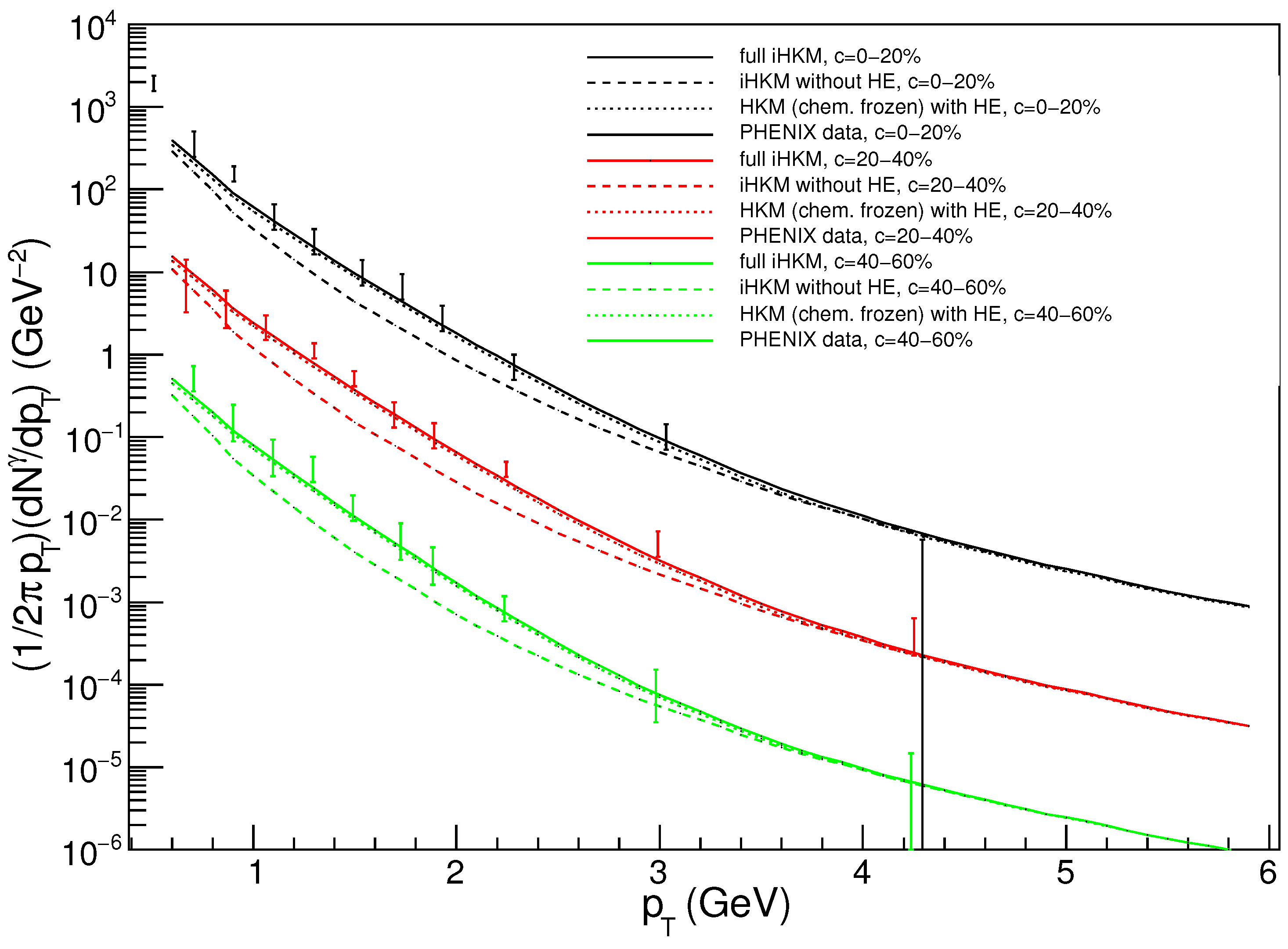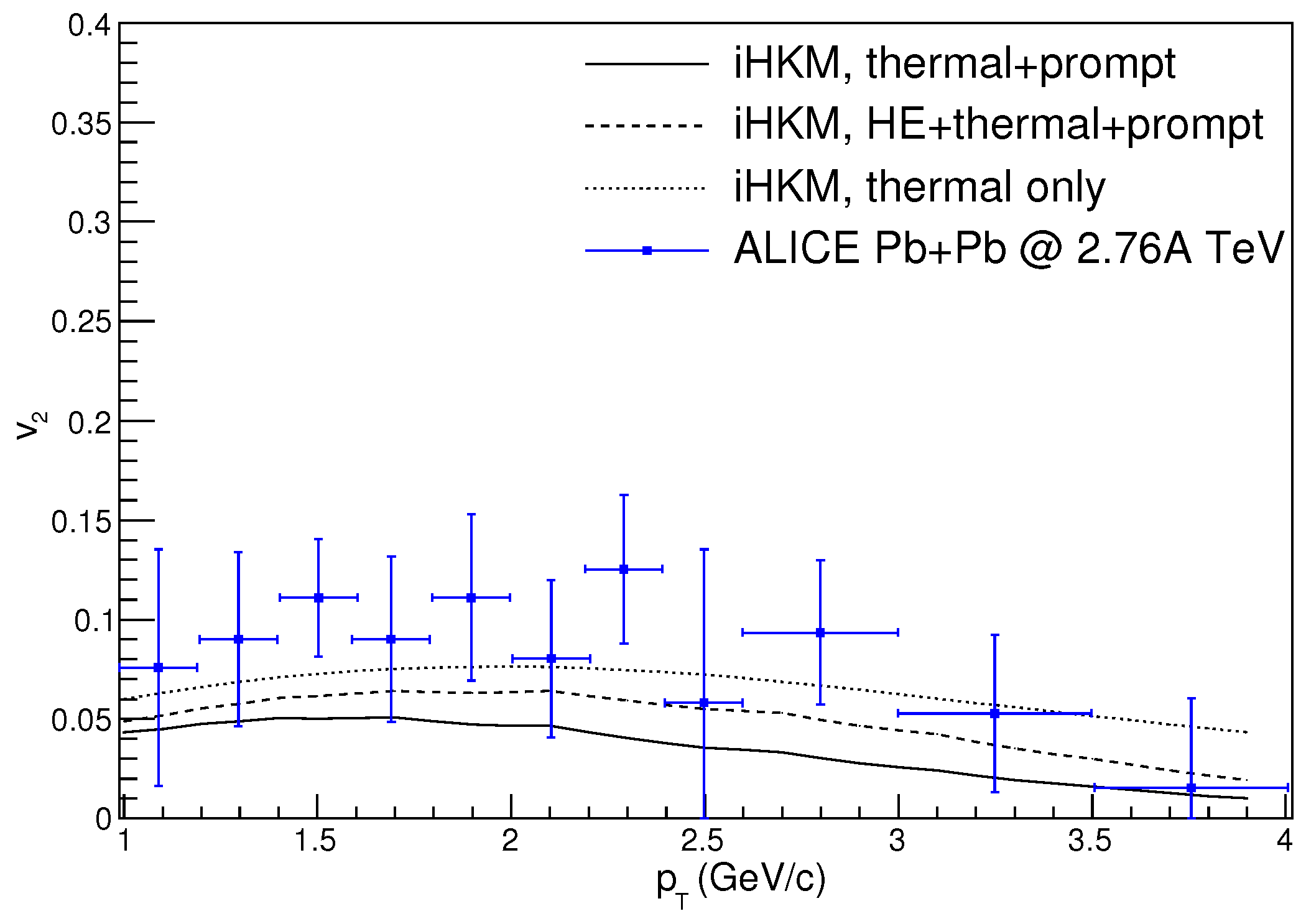Direct Photon Production in High-Energy Heavy Ion Collisions within the Integrated Hydrokinetic Model
Abstract
:1. Introduction
2. Photon Emission Sources
2.1. Prompt Photons
2.2. Pre-Equilibrium and Thermal Photons
- The photons radiating from a meson gas. Here we base our consideration on the Reference [65]. We account for the hadronic reactions with , K and mesons and resonances, where photons are produced. The corresponding emission rates are taken from [65] with one additional prescription for the chemically frozen evolution regime: in this case the contribution from each hadronic reaction has to be multiplied by , where represent the individual chemical potentials of hadrons participating in the reaction.
- The photons coming from in-medium mesons. Here we follow the results of the Reference [66]. The emission rate for these photons incorporates baryon (antibaryon) effects and in our analysis depends on the local baryon chemical potential (for chemical equilibrium expansion), and, in addition, on individual chemical potentials of hadrons involved in reaction (for chemically frozen evolution).
- The photons emitted in reactions with the three mesons , and [19], such as , , and . Again, for the chemically frozen regime the corresponding contributions should be multiplied by .
- The photons originating from bremmstrahlung [66].
2.3. Hadronization Photons
3. Results and Discussion
4. Conclusions
Author Contributions
Funding
Conflicts of Interest
References
- Naboka, V.Y.; Akkelin, S.V.; Karpenko, I.A.; Sinyukov, Y.M. Initialization of hydrodynamics in relativistic heavy ion collisions with an energy-momentum transport model. Phys. Rev. C 2015, 91, 014906. [Google Scholar] [CrossRef] [Green Version]
- Naboka, V.Y.; Karpenko, I.A.; Sinyukov, Y.M. Thermalization, evolution, and observables at energies available at the CERN Large Hadron Collider in an integrated hydrokinetic model of A+A collisions. Phys. Rev. C 2016, 93, 024902. [Google Scholar] [CrossRef]
- Shapoval, V.M.; Braun-Munzinger, P.; Sinyukov, Y.M. K*(892) and ϕ(1020) production and their decay into the hadronic medium at the Large Hadron Collider. Nucl. Phys. A 2017, 968, 391. [Google Scholar] [CrossRef] [Green Version]
- Sinyukov, Y.M.; Shapoval, V.M. Particle production at energies available at the CERN Large Hadron Collider within evolutionary model. Phys. Rev. C 2018, 97, 064901. [Google Scholar] [CrossRef] [Green Version]
- Shapoval, V.M.; Sinyukov, Y.M. Bulk observables in Pb+Pb collisions at = 5.02 TeV at the CERN Large Hadron Collider within the integrated hydrokinetic model. Phys. Rev. C 2019, 100, 044905. [Google Scholar] [CrossRef] [Green Version]
- Adzhymambetov, M.D.; Shapoval, V.M.; Sinyukov, Y.M. Description of bulk observables in Au+Au collisions at top RHIC energy in the integrated hydrokinetic model. Nucl. Phys. A 2019, 987, 321. [Google Scholar] [CrossRef] [Green Version]
- Sinyukov, Y.; Adzhymambetov, M.; Shapoval, V. Particle Production in Xe+Xe Collisions at the LHC within the Integrated Hydrokinetic Model. Particles 2020, 3, 114–122. [Google Scholar] [CrossRef] [Green Version]
- Feinberg, E.L. Perturbative approach to some one-dimensional many-body problems. I: Discussion of the Rayleigh-Schrödinger and Brillouin-Wigner series for the Sutherland model. Il Nuovo Cimento B 1976, 34, 391. [Google Scholar]
- Shuryak, E.V. Quark-Gluon Plasma and Hadronic Production of Leptons, Photons and Psions. Sov. J. Nucl. Phys. 1978, 28, 408. [Google Scholar] [CrossRef]
- Ruuskanen, P.V. Electromagnetic probes of quark-gluon plasma in relativistic heavy-ion collisions. Nucl. Phys. A 1992, 544, 169. [Google Scholar] [CrossRef]
- Thoma, M.H. Damping rate of a hard photon in a relativistic plasma. Phys. Rev. D 1995, 51, 862. [Google Scholar] [CrossRef] [Green Version]
- Roy, P.; Sarkar, S.; Alam, J.; Sinha, B. Electromagnetic radiation from hot and dense hadronic matter. Nucl. Phys. A 1999, 653, 277. [Google Scholar] [CrossRef] [Green Version]
- Paquet, J.-F.; Shen, C.; Denicol, G.S.; Luzum, M.; Schenke, B.; Jeon, S.; Gale, C. Production of photons in relativistic heavy-ion collisions. Phys. Rev. C 2016, 93, 044906. [Google Scholar] [CrossRef]
- Berges, J.; Reygers, K.; Tanji, N.; Venugopalan, R. Parametric estimate of the relative photon yields from the glasma and the quark-gluon plasma in heavy-ion collisions. Phys. Rev. C 2017, 95, 054904. [Google Scholar] [CrossRef] [Green Version]
- Chiu, M.; Hemmick, T.K.; Khachatryan, V.; Leonidov, A.; Liao, J.; McLerran, L. Production of Photons and Dileptons in the Glasma. Nucl. Phys. A 2013, 900, 16. [Google Scholar] [CrossRef] [Green Version]
- van Hees, H.; Gale, C.; Rapp, R. Thermal photons and collective flow at energies available at the BNL Relativistic Heavy-Ion Collider. Phys. Rev. C 2011, 84, 054906. [Google Scholar] [CrossRef] [Green Version]
- Rapp, R.; van Hees, H.; He, M. Properties of thermal photons at RHIC and LHC. Nucl. Phys. A 2014, 931, 696. [Google Scholar] [CrossRef] [Green Version]
- Gale, C. Photon production in hot and dense strongly interacting matter, in: Landolt–Bornstein—Group I Elementary Particles, Nuclei and Atoms. Relativ. Heavy Ion Phys. 2010, 23, 445. [Google Scholar]
- Holt, N.P.M.; Hohler, P.M.; Rapp, R. Thermal photon emission from the πρω system. Nucl. Phys. A 2016, 945, 1. [Google Scholar] [CrossRef] [Green Version]
- Fries, R.J.; Muller, B.; Srivastava, D.K. High-Energy Photons from Passage of Jets through Quark-Gluon Plasma. Phys. Rev. Lett. 2003, 90, 132301. [Google Scholar] [CrossRef] [Green Version]
- Turbide, S.; Gale, C.; Frodermann, E.; Heinz, U. Electromagnetic radiation from nuclear collisions at ultrarelativistic energies. Phys. Rev. C 2008, 77, 024909. [Google Scholar] [CrossRef] [Green Version]
- Adare, A.; Afanasiev, S.; Aidala, C.; Ajitanand, N.N.; Akiba, Y.; Al-Bataineh, H.; Alexander, J.; Al-Jamel, A.; Aoki, K.; Aphecetche, L.; et al. Enhanced Production of Direct Photons in Au+Au Collisions at = 200 GeV and Implications for the Initial Temperature. Phys. Rev. Lett. 2010, 104, 132301. [Google Scholar] [CrossRef] [PubMed] [Green Version]
- Adare, A.; Afanasiev, S.; Aidala, C.; Ajitanand, N.N.; Akiba, Y.; Al-Bataineh, H.; Alexander, J.; Aoki, K.; Aramaki, Y.; Atomssa, E.T.; et al. Observation of Direct-Photon Collective Flow in Au+Au Collisions at = 200 GeV. Phys. Rev. Lett. 2012, 109, 122302. [Google Scholar] [CrossRef] [Green Version]
- Adare, A.; Afanasiev, S.; Aidala, C.; Ajitanand, N.N.; Akiba, Y.; Al-Bataineh, H.; Alexander, J.; Al-Jamel, A.; Aoki, K.; Aphecetche, L.; et al. Detailed measurement of the e+e− pair continuum in p+p and Au+Au collisions at = 200 GeV and implications for direct photon production. Phys. Rev. C 2010, 81, 034911. [Google Scholar] [CrossRef] [Green Version]
- Adare, A.; Afanasiev, S.; Aidala, C.; Ajitanand, N.N.; Akiba, Y.; Akimoto, R.; Al-Bataineh, H.; Al-Ta’ani, H.; Alexander, J.; Angerami, A.; et al. Centrality dependence of low-momentum direct-photon production in Au+Au collisions at = 200 GeV. Phys. Rev. C 2015, 91, 064904. [Google Scholar] [CrossRef] [Green Version]
- Wilde, M.; ALICE Collaboration. Measurement of Direct Photons in pp and Pb-Pb Collisions with ALICE. Nucl. Phys. A 2013, 904, 573c. [Google Scholar] [CrossRef] [Green Version]
- Lohner, D.; ALICE Collaboration. Measurement of Direct-Photon Elliptic Flow in Pb-Pb Collisions at = 2.76 TeV. J. Phys. Conf. Ser. 2013, 446, 012028. [Google Scholar] [CrossRef] [Green Version]
- Adam, J.; Adamová, D.; Aggarwal, M.M.; Aglieri Rinella, G.; Agnello, M.; Agrawal, N.; Ahammed, Z.; Ahn, S.U.; Aiola, S.; Akindinov, A.; et al. Direct photon production in Pb–Pb collisions at = 2.76 TeV. Phys. Lett. B 2016, 754, 235. [Google Scholar]
- Holopainen, H.; Räsänen, S.S.; Eskola, K.J. Elliptic flow of thermal photons in heavy-ion collisions at energies available at the BNL Relativistic Heavy Ion Collider and at the CERN Large Hadron Collider. Phys. Rev. C 2011, 84, 064903. [Google Scholar] [CrossRef] [Green Version]
- Chaudhuri, A.K.; Sinha, B. Direct photon production from viscous quark-gluon plasma. Phys. Rev. C 2011, 83, 034905. [Google Scholar] [CrossRef] [Green Version]
- Shen, C.; Heinz, U.; Paquet, J.-F.; Gale, C. Thermal photons as a quark-gluon plasma thermometer reexamined. Phys. Rev. C 2014, 89, 044910. [Google Scholar] [CrossRef] [Green Version]
- Liu, F.-M.; Liu, S.-X. Quark-gluon plasma formation time and direct photons from heavy ion collisions. Phys. Rev. C 2014, 89, 034906. [Google Scholar] [CrossRef] [Green Version]
- Chatterjee, R.; Holopainen, H.; Helenius, I.; Renk, T.; Eskola, K.J. Elliptic flow of thermal photons from an event-by-event hydrodynamic model. Phys. Rev. C 2013, 88, 034901. [Google Scholar] [CrossRef] [Green Version]
- Chatterjee, R.; Srivastava, D.K.; Renk, T. Triangular flow of thermal photons from an event-by-event hydrodynamic model for 2.76A TeV Pb+Pb collisions at the CERN Large Hadron Collider. Phys. Rev. C 2016, 94, 014903. [Google Scholar] [CrossRef] [Green Version]
- Kim, Y.-M.; Lee, C.-H.; Teaney, D.; Zahed, I. Direct photon elliptic flow at energies available at the BNL Relativistic Heavy Ion Collider and the CERN Large Hadron Collider. Phys. Rev. C 2017, 96, 015201. [Google Scholar] [CrossRef] [Green Version]
- Basar, G.; Kharzeev, D.E.; Skokov, V. Conformal Anomaly as a Source of Soft Photons in Heavy Ion Collisions. Phys. Rev. Lett. 2012, 109, 202303. [Google Scholar] [CrossRef] [Green Version]
- Müller, B.; Wu, S.-Y.; Yang, D.-L. Elliptic flow from thermal photons with magnetic field in holography. Phys. Rev. D 2014, 89, 026013. [Google Scholar] [CrossRef] [Green Version]
- Zakharov, B. Induced photon emission from quark jets in ultrarelativistic heavy-ion collisions. JETP Lett. 2014, 80, 1. [Google Scholar] [CrossRef] [Green Version]
- Tuchin, K. Role of magnetic field in photon excess in heavy ion collisions. Phys. Rev. C 2015, 91, 014902. [Google Scholar] [CrossRef] [Green Version]
- Goloviznin, V.V.; Snigirev, A.M.; Zinovjev, G.M. Towards azimuthal anisotropy of direct photons. JETP Lett. 2013, 98, 61. [Google Scholar] [CrossRef] [Green Version]
- Kharzeev, D.E.; Loshaj, F. Anomalous soft photon production from the induced currents in Dirac sea. Phys. Rev. D 2014, 89, 074053. [Google Scholar] [CrossRef] [Green Version]
- Campbell, S. Photon production from gluon-mediated quark–anti-quark annihilation at confinement. Phys. Rev. C 2015, 92, 014907. [Google Scholar] [CrossRef] [Green Version]
- Young, C.; Pratt, S. Electromagnetic recombination spectra at the quark-hadron phase transition. Phys. Rev. C 2016, 94, 044916. [Google Scholar] [CrossRef] [Green Version]
- Fujii, H.; Itakura, K.; Nonaka, C. Photon emission at hadronization. Nucl. Phys. A 2017, 967, 704. [Google Scholar] [CrossRef]
- Naboka, V.Y.; Sinyukov, Y.M.; Zinovjev, G.M. Direct-photon spectrum and elliptic flow produced from Pb+Pb collisions at = 2.76 TeV at the CERN Large Hadron Collider within an integrated hydrokinetic model. Phys. Rev. C 2018, 97, 054907. [Google Scholar] [CrossRef] [Green Version]
- Naboka, V.Y.; Sinyukov, Y.M.; Zinovjev, G.M. Photon spectra and anisotropic flow in heavy ion collisions at the top RHIC energy within the integrated hydrokinetic model with photon hadronization emission. Nucl. Phys. A 2020, 1000, 121843. [Google Scholar] [CrossRef] [Green Version]
- Aad, G.; Abbott, B.; Abdallah, J.; Abdel Khalek, S.; Abdinov, O.; Aben, R.; Abi, B.; Abolins, M.; AbouZeid, O.S.; Abramowicz, H.; et al. Centrality, rapidity, and transverse momentum dependence of isolated prompt photon production in lead-lead collisions at = 2.76 TeV measured with the ATLAS detector. Phys. Rev. C 2016, 93, 034914. [Google Scholar] [CrossRef] [Green Version]
- Chatrchyan, S.; Khachatryan, V.; Sirunyan, A.M.; Tumasyan, A.; Adam, W.; Bergauer, T.; Dragicevic, M.; Erö, J.; Fabjan, C.; Friedl, M.; et al. Measurement of isolated photon production in pp and PbPb collisions at = 2.76 TeV. Phys. Lett. B 2012, 710, 256. [Google Scholar] [CrossRef]
- Abelev, B.; Adam, J.; Adamová, D.; Adare, A.M.; Aggarwal, M.M.; Aglieri Rinella, G.; Agnello, M.; Agocs, A.G.; Agostinelli, A.; Ahammed, Z.; et al. Centrality determination of Pb-Pb collisions at = 2.76 TeV with ALICE. Phys. Rev. C 2013, 88, 044909. [Google Scholar] [CrossRef] [Green Version]
- Aurenche, P.; Guillet, J.P.; Pilon, E.; Werlen, M.; Fontannaz, M. Recent critical study of photon production in hadronic collisions. Phys. Rev. D 2006, 73, 094007. [Google Scholar] [CrossRef] [Green Version]
- Eskola, K.; Paukkunen, H.; Salgado, C. EPS09—A new generation of NLO and LO nuclear parton distribution functions. J. High Energy Phys. 2009, 4, 065. [Google Scholar] [CrossRef] [Green Version]
- Bourhis, L.; Fontannaz, M.; Guillet, J.P. Quark and gluon fragmentation functions into photons. Eur. Phys. J. C 1998, 2, 529. [Google Scholar] [CrossRef]
- Akkelin, S.V.; Sinyukov, Y.M. Matching of nonthermal initial conditions and hydrodynamic stage in ultrarelativistic heavy-ion collisions. Phys. Rev. C 2010, 81, 064901. [Google Scholar] [CrossRef] [Green Version]
- Broniowski, W.; Rybczynski, M.; Bozek, P. GLISSANDO: GLauber Initial-State Simulation AND mOre. Comput. Phys. Commun. 2009, 180, 69. [Google Scholar] [CrossRef] [Green Version]
- Rybczynski, M.; Stefanek, G.; Broniowski, W.; Bozek, P. GLISSANDO 2: GLauber Initial-State Simulation AND mOre..., ver. 2. Comput. Phys. Commun. 2014, 185, 1759. [Google Scholar] [CrossRef] [Green Version]
- Bozek, P.; Broniowski, W.; Rybczynski, M.; Stefanek, G. GLISSANDO 3: GLauber Initial-State Simulation AND mOre..., ver. 3. Comput. Phys. Commun. 2019, 245, 106850. [Google Scholar] [CrossRef] [Green Version]
- Laine, M.; Schroeder, Y. Quark mass thresholds in QCD thermodynamics. Phys. Rev. D 2006, 73, 085009. [Google Scholar] [CrossRef] [Green Version]
- Huovinen, P.; Petersen, H. Particlization in hybrid models. Eur. Phys. J. A 2012, 48, 171. [Google Scholar] [CrossRef] [Green Version]
- Bass, S.A.; Belkacem, M.; Bleicher, M.; Brandstetter, M.; Bravina, L.; Ernst, C.; Gerland, L.; Hofmann, M.; Hofmann, S.; Konopka, J.; et al. Microscopic Models for Ultrarelativistic Heavy Ion Collisions. Prog. Part. Nucl. Phys. 1998, 41, 225. [Google Scholar] [CrossRef] [Green Version]
- Bleicher, M.; Zabrodin, E.; Spieles, C.; Bass, S.A.; Ernst, C.; Soff, S.; Bravina, L.; Belkacem, M.; Weber, H.; Stocker, H.; et al. Relativistic Hadron-Hadron Collisions in the Ultra-Relativistic Quantum Molecular Dynamics Model. J. Phys. G Nucl. Part. Phys. 1999, 25, 1859. [Google Scholar] [CrossRef]
- Karpenko, I.A.; Sinyukov, Y.M. Kaon and pion femtoscopy at the highest energies available at the BNL Relativistic Heavy Ion Collider (RHIC) in a hydrokinetic model. Phys. Rev. C 2010, 81, 054903. [Google Scholar] [CrossRef] [Green Version]
- Arnold, P.B.; Moore, G.D.; Yaffe, L.G. Photon emission from quark-gluon plasma: Complete leading order results. J. High Energy Phys. 2001, 12, 009. [Google Scholar] [CrossRef]
- Aurenche, P.; Gelis, F.; Zaraket, H. Kinoshita-Lee-Nauenberg theorem, magnetic mass, and thermal photon production. Phys. Rev. D 2000, 61, 116001. [Google Scholar] [CrossRef] [Green Version]
- Ghiglieri, J.; Hong, J.; Kurkela, A.; Lu, E.; Moore, G.D.; Teaney, D. Next-to-leading order thermal photon production in a weakly coupled quark-gluon plasma. J. High Energy Phys. 2013, 5, 010. [Google Scholar] [CrossRef] [Green Version]
- Turbide, S.; Rapp, R.; Gale, C. Hadronic production of thermal photons. Phys. Rev. C 2004, 69, 014903. [Google Scholar] [CrossRef] [Green Version]
- Heffernan, M.; Hohler, P.; Rapp, R. Universal parametrization of thermal photon rates in hadronic matter. Phys. Rev. C 2015, 91, 027902. [Google Scholar] [CrossRef] [Green Version]
- Nayak, G.C. Parton to Hadron Fragmentation Function from Quark-Gluon Plasma using Lattice QCD Method at Finite Temperature. arXiv 2019, arXiv:1904.05376. [Google Scholar]
- Akkelin, S.V.; Hama, Y.; Karpenko, I.A.; Sinyukov, Y.M. Hydro-kinetic approach to relativistic heavy ion collisions. Phys. Rev. C 2008, 78, 034906. [Google Scholar] [CrossRef]
- Sinyukov, Y.M.; Akkelin, S.V.; Karpenko, I.A. Kinetics Versus Hydrodynamics: Generalization of Landau/Cooper–Frye Prescription for Freeze-Out. Act. Phys. Pol. B 2009, 40, 1025. [Google Scholar]
- Adamczyk, L.; Adkins, J.K.; Agakishiev, G.; Aggarwal, M.M.; Ahammed, Z.; Ajitanand, N.N.; Alekseev, I.; Anderson, D.M.; Aoyama, R.; Aparin, A.; et al. Direct virtual photon production in Au+Au collisions at = 200 GeV. Phys. Lett. B 2017, 770, 451. [Google Scholar] [CrossRef]
- Adare, A.; Afanasiev, S.; Aidala, C.; Ajitanand, N.N.; Akiba, Y.; Akimoto, R.; Al-Bataineh, H.; Alexander, J.; Alfred, M.; Al-Ta’ani, H.; et al. Azimuthally anisotropic emission of low-momentum direct photons in Au+Au collisions at = 200 GeV. Phys. Rev. C 2016, 94, 064901. [Google Scholar] [CrossRef] [Green Version]
- Roman, V.C.; PHENIX Collaboration. Direct Photons at the PHENIX Experiment: From Large to Small Systems. Proceedings 2019, 10, 32. [Google Scholar] [CrossRef] [Green Version]
- Lohner, D. Anisotropic Flow of Direct Photons in Pb-Pb Collisions at 2.76 TeV Per Nucleon. Ph.D. Thesis, University of Heidelberg, Heidelberg, Germany, 2013. [Google Scholar]




| Centrality, % | Prompt | Thermal | Hadroniz. | Total | ||
|---|---|---|---|---|---|---|
| 0–20 | 567 | 0.2471 | 0.5000 | 0.5499 | 1.2970 | 1.2970 |
| 20–40 | 236 | 0.0905 | 0.1727 | 0.2314 | 0.4946 | 0.4337 |
| 40–60 | 98 | 0.0265 | 0.0456 | 0.0751 | 0.1472 | 0.1446 |
Publisher’s Note: MDPI stays neutral with regard to jurisdictional claims in published maps and institutional affiliations. |
© 2022 by the authors. Licensee MDPI, Basel, Switzerland. This article is an open access article distributed under the terms and conditions of the Creative Commons Attribution (CC BY) license (https://creativecommons.org/licenses/by/4.0/).
Share and Cite
Sinyukov, Y.; Shapoval, V. Direct Photon Production in High-Energy Heavy Ion Collisions within the Integrated Hydrokinetic Model. J 2022, 5, 1-14. https://doi.org/10.3390/j5010001
Sinyukov Y, Shapoval V. Direct Photon Production in High-Energy Heavy Ion Collisions within the Integrated Hydrokinetic Model. J. 2022; 5(1):1-14. https://doi.org/10.3390/j5010001
Chicago/Turabian StyleSinyukov, Yuri, and Volodymyr Shapoval. 2022. "Direct Photon Production in High-Energy Heavy Ion Collisions within the Integrated Hydrokinetic Model" J 5, no. 1: 1-14. https://doi.org/10.3390/j5010001
APA StyleSinyukov, Y., & Shapoval, V. (2022). Direct Photon Production in High-Energy Heavy Ion Collisions within the Integrated Hydrokinetic Model. J, 5(1), 1-14. https://doi.org/10.3390/j5010001





